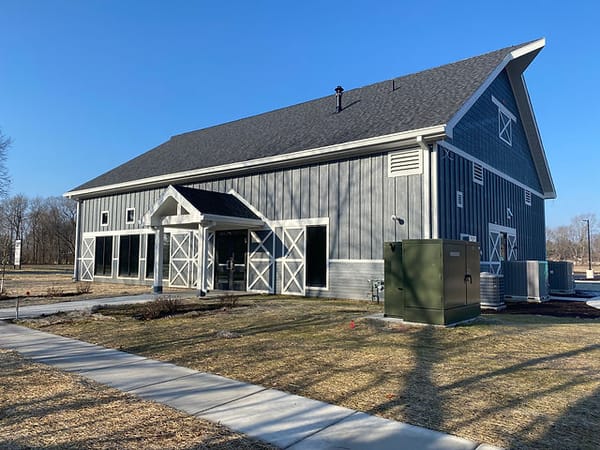Chemtool fire dwindles, cleanup continues, lawsuits emerge
Only a few hot spots are left in the Chemtool fire, but lawsuits may be heating up.

In the next few days, firefighters expect to finish putting out the Chemtool fire at 1165 Prairie Hill Road in Rockton, Illinois, which has burned since a massive explosion at 7:00 a.m. Monday, June 17. Chemtool's parent company, Lubrizol, hired a private fire-fighting company, US Fire Pump, which is now leading fire suppression efforts. According to the EPA website, "The number of hot spots remaining at the site dropped from 13 on Sunday to five as of [Monday] morning." The evacuation order ended on Friday, June 18.
Attorneys have announced several lawsuits against Chemtool for not preventing the fire, for inconveniencing Rockton residents, and possibly injuring their health. For what it's worth, the Illinois EPA's website says, "Preliminary results of initial samples indicate NO DETECTION of semivolatile organic compounds. Current data indicates no violations of national ambient air quality standards and no significant concerns at the ground level. " According to the U.S. EPA, average levels of VOCs (volatile organic compounds) in the area don't exceed 0.09 ppm (parts per million). Levels of H2S gas (hydrogen sulfide) are at 0.0 ppm. Hydrogen sulfide has a rotten egg smell. The U.S. EPA had detected an increase in particles when the fire flared up. The Illinois EPA and U.S. EPA continues to oversee site remediation as recovery and clean-up from the event.
As we reported last week, part of the Rock River has been temporarily closed to recreational boats, but not for the reason you might think. The Illinois Department of Natural Resources announced, "Due to the Chemtool fire, and the ongoing efforts of emergency personnel, IDNR Conservation Police have determined that navigation of the Rock River is significantly dangerous to the public at this time. Until further notice, the Rock River is now closed to recreational boat traffic from the Rockton Dam, in Winnebago County, upstream to the border of Wisconsin." But they later clarified that "the temporary closure of the Rock River near the Chemtool fire has nothing to do with potential contamination, but rather low water levels and emergency personnel working in the area."
The Lubrizol Foundation hired Clean Harbors to handle debris removal from the fire. Residents should call them at 877-552-8942 instead of touching any debris themselves. Lubrizol told WREX, "While to-date date test results point to no impact to water systems, Chemtool is offering bottled water for residents with private wells in the evacuation area as wells are tested. Residents should reach out to connect@lubrizol.com to request support."
On June 15, Bill Snyder, Vice President of Operations for Lubrizol, told a press conference, "We're here to support the community... We're going to do everything we can to do the right thing..." Chemtool has been in operation in Rockton since 2008, "we've operated safely all of those year." Lubrizol bought the company in 2013 and has spent over $70 million for improvements since then, about half of which was safety-related - "materials handling, warehouse racking, cleanliness of the facility." Besides US Fire Pump, Snyder says Lubrizol has brought in its own cleanup and remediation experts, as well as their own experts in toxicology, air and water quality. Snyder said, "We're going to continue to cooperate fully" with any government investigations," but "based on everything we know about the materials that are present at the site and about what happens when they're involved in a fire, we don't foresee any concerns over short or long term health impacts as a result of the fire."
An annual fire inspection report obtained by WREX said that the facility was not "completely sprinklered" and "properly protected" on November 20, 2020. Alicia Gauer, Lubrizol Senior Director of Global Communications told WREX, "The Rockton site was in compliance with applicable regulations, and regular visits were made by the proper authorities. We did not have sprinklers in the immediate area we believe the fire started based on our to-date investigation, though we did have sprinklers in other areas of the site."
Keith Woller, business agent for Sprinklerfitters Local 669, told WREX, "The contractor has already done the prints and ordered the material and everything that needed to be done to get that plant sprinkled. And I believe they were still waiting on permits and paperwork to get started. It's weird timing."
On Monday's air quality report, the U.S. EPA reported that levels of HCN (hydrogen cyanide, also called prussic acid) had slightly exceeded the "public health screening level" of 1 ppm when tested at the corner of Union and Ferry and near the stop sign on Chapel and Bridge Street. The HCN levels reached 1.6 ppm at the most, while the average at those two locations was 0.2 ppm. At all other testing locations, HCN averaged zero parts per million - none detected - even at testing locations closer to the Chemtool site. Even the day after the fire began, all HCN measurements were at zero.
HCN is an important industrial chemical, with a bitter almond smell, but HCN can also be fatal - though only at air levels higher than anything being measured in Rockton. Almonds have trace amounts of HCN, but low enough that the human body can neutralize them. The "nut" inside of a peach pit looks like an almond (almonds and peaches are related), but don't eat it. In ancient Egypt, traitors were fed peach pits - the ancient Egyptians called this "death by peach." The pits and seeds of cherries, apricots, and apples also contain high levels of HCN. In the air, according to the International Cyanide Management Institute, symptoms at levels of 20 to 40 ppm may include "headache, drowsiness, vertigo, weak and rapid pulse, deep and rapid breathing, a bright-red color in the face, nausea and vomiting." Again, that's at levels about 15 times higher than anything measured in Rockton.
The company is inviting Rockton residents and businesses to send them reimbursement and debris removal claims. However, the Individual Claim Form says, "DEPENDING ON THE AMOUNT OF YOUR CLAIM, CHEMTOOL RESERVES THE RIGHT TO REQUIRE YOU TO EXECUTE A RELEASE OF CLAIMS AGAINST CHEMTOOL PRIOR TO MAKING ANY PAYMENT." The Business Claim Form says, "NO PAYMENT WILL BE MADE BY OR ON BEHALF OF CHEMTOOL WITHOUT THE CLAIMANT EXECUTING A RELEASE OF CLAIMS AGAINST CHEMTOOL."
In spite of test results currently showing no danger, some residents aren't taking any chances. A class action lawsuit filed by The Collins Law Firm and Miner Barnhill & Galland alleges that Chemtool should have prevented the disaster. Their news release says, "The lawsuit seeks damages for nuisance, trespass, and the loss of use and enjoyment of their homes." The complaint says that residents had to wear masks and stay inside without air conditioning, and weren't allowed to return home "even for medication, technology and communication devices, or other personal items." A hearing for the class action lawsuit is scheduled for September 16 in Winnebago County 17th Judicial Circuit Court.
An individual lawsuit has filed against Chemtool by Meyers-Flowers of Chicago and Clark Frost Zucchi of Rockford on behalf of two other Rockton residents. Among other claims, it alleges that "US Fire Pumps poured 71,000 gallons of water laced with 3,200 gallons of PFAs-laden foam onto the fire before switching the mix, at the urging of health authorities, to a foam that did not contain PFAs."
As we reported, on the first day of the fire, U.S. EPA and Illinois EPA had strongly warned Chemtool not to use PFAS-containing foam. But US Fire Pump had started pumping fire-suppression foam with PFAS before Chemtool had talked to them about it. When Rockton Fire Chief Kirk Wilson found out what had happened, he told US Fire Pump to switch to a non-fluorinated foam. Even before any foam was used, the Illinois EPA had deployed "absorbent boom" to protect the Rock River from spills. On June 17, a foam spill did occur, and the EPA believes they were able to contain it, but they collected samples.
Cody Adams, Senior Public Relations Manage at Lubrizol, replied that even before US Fire Pumps applied the diluted fluorinated foam, their teams took steps to be able to contain it, "digging containment trenches around the property, applying absorbent materials and vacuuming foam and water into industrial storage tanks for appropriate disposal." Adams also said, "Fluorinated foam is twice as effective as non-fluorinated foam in suppressing a fire like the one we experienced and offered the best chance to control the fire in the shortest amount of time." US Fire Pumps used it for about three hours before switching.
The U.S. EPA says, "All wastewater from the site is currently stored in tanks onsite and will be characterized for disposal before being shipped to an appropriate facility. All state and federal regulations for waste disposal will be followed."
A spokesperson for Meyers-Flowers, in contradiction to the EPA's reports, claims, "Since the fire, there hasn’t been testing of the ground or the water, even after all kinds of chemicals from the explosion and fighting the fire have been released into the air. Additional complaints are expected to be filed by the Meyers & Flowers team in the coming days. Peter Flowers is available for interviews today and tomorrow."





